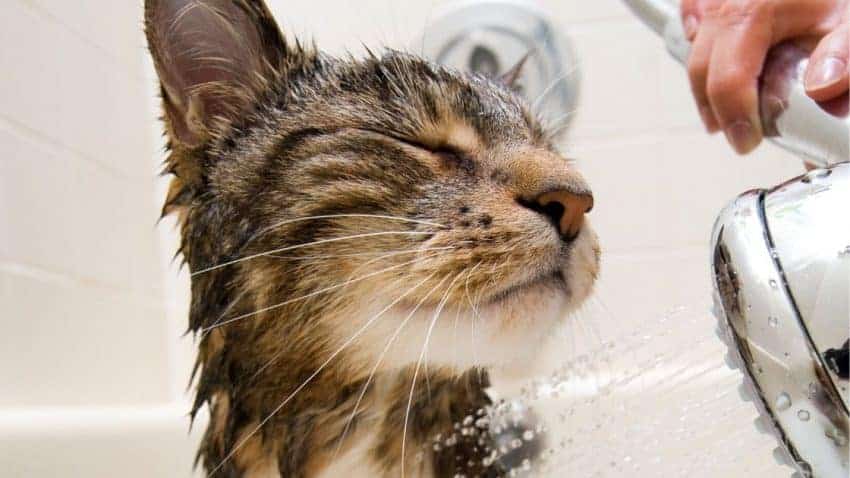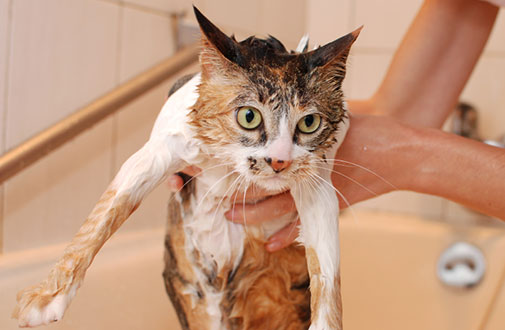For those of you that have been pet parents for a while, you have probably dealt with fleas at one point.
Those nasty little bugs come out to play during warm months, especially during summer. They creep up on your cat and put up shop sucking on his blood whenever they choose.
As if that’s not enough, the females will lay eggs and keep the cycle going. According to PetMD, fleas can lay up to 50 eggs per day. Those are no small numbers.
Fleas have no place in your pet’s body. For one, they transmit diseases and infections both for the kitty and the rest of the family.
Eradicating them is another story altogether. The pupae can hibernate and go without food for a year. Even as adults, they can go for 14 days without sucking blood.
Fortunately, there are several strategies you can use to eradicate the bugs once and for all.
One of the most effective ones is bathing the cat with flea shampoo or dish soap. This method kills both the adult bugs and most importantly the eggs.
However, if your cat is not a fan of the water, things can really get complicated. If yours fits the profile, we have a few suggestions on how to rid him of fleas.
Get the Cat Used To Water

You have probably tried every trick by the book to get your cat to fall in love with the water to no avail. Still, one last trial wouldn’t hurt.
Ideally, most cats don’t fancy being in the water. It runs in their DNA.
Feline ancestors were desert creatures who never came in contact with large water bodies. As such, they lack the experience of swimming and being around water.
To make the matters worse, their coats hold water and reduce their body temperature and ultimately making them chilled.
Although your kitty is not designed by nature to seek out the water experienced, he can be trained to tolerate (and possibly enjoy) being given baths.
The trick is to be gradual and assure the kitty that she’s safe in his tub full of water.
To get your kitty used to water, do the following:
1. Use A Small Tub
Your bathroom tub is great and all but don’t bathe your water in there unless you have another smaller tub inside of it.
If you know a thing or two about cats, you’ll confirm that they like to be on top of things. The minute they feel vulnerable, they will look for the next available exit.
A tub full of water certainly makes them vulnerable. On the other hand, a smaller tub gives them some control over their surroundings.
2. Be Gradual
This is perhaps the most important trick when training a cat to get used to the water. You want to remain below your cat’s fear threshold.
Initially, be sure to keep the water height low on the tub. Only increase when the kitty feels comfortable but never goes past his chest.
When ready, entice your cat to come over for a bath. Use treats to catch her attention.
Once she cooperates, scoop some water and splash it over her paws and watch what happens.
Next, encourage him to dip his little paws into the shallow tub of water then another paw, and another until the body is dipped in water.
Now apply the shampoo, rinse the pet, and dry her thoroughly.
Never force her into anything.
3. Check The Temperature Of The Water
Comfort is a priority in the feline world.
The temperature of the bathwater determines whether you will be successful with the cat or not.
Essentially, you want to keep things at his body temperature which is warm but not too hot to touch.
4. Be Gentle and Calm
As you bathe your cat, it is essential that you remain calm and be gentle the entire time. Remember kitties can sense anxiety from you and will respond negatively to it.
Similarly, avoid sudden movements, being too intense, singing loudly, or using a spray hose.
These things will only scare the cat and you will reach nowhere in your efforts to remove fleas.
Try Other Flea Removal Strategies

Even after trying the above tips, some cats just won’t budge. For such, the solution is to use other flea remedies.
Lucky for you, they are quite the number. Here are some of them.
A. Spot-on treatments
These are medicinal liquids that are poured on the cat’s back, neck, and shoulders.
The pet will then absorb it and transport it to the rest of the body via his circulatory system.
In the process, any flea or tick that is lodged in the cat’s skin will ingest the medicine and die.
Some also prevent eggs from hatching making it a holistic solution.
B. Topical Treatments
Although topical treatments oils are not dry, they can work for a cat that is afraid of being dipped in a basin full of water.
You can spray them over your cat’s body and gently massage them in to get rid of the bugs.
Examples of topical treatments include apple cider vinegar, lavender essential oil, rosemary, chamomile, and lemon juice.
Talk to your vet to know the right concentrations and dosages for your kitty and you are good to go.
C. Flea combs
For a cat that doesn’t like the water, a good flea comb can save the day. It is an old trick that introduces flea shampoo without dumping water all over his body.
Simply grab a flea comb and comb in the direction of your kitty’s fur.
Next, dunk the comb into the water and comb out fleas and eggs trapped in the fur.
Repeat the process with the main focus in problem areas such as the groin area, armpits, the base of the ear, around the neck, and tail base.
Parting Thoughts
Cats are clean but they don’t like the water experience very much. However, with the right approach, you can get yours used to the water. If you are not successful, move on to other flea remedies.
Most importantly, do a full house eradication of the infestation to keep the bugs away for good.

Hi! I am Eleanor Price. I started this website after my cat, Louie, almost died from a case of botulism (a type of food poisoning often caused by bacteria that grow on food items). Turned out that my cat’s diet was the problem. I have made it my duty to provide the best information and recommendations about everything cat lovers need to know about their felines’ health and wellbeing. My goal is to find the most informative content on anything feline-related and share it with fellow hardworking kitty lovers.

